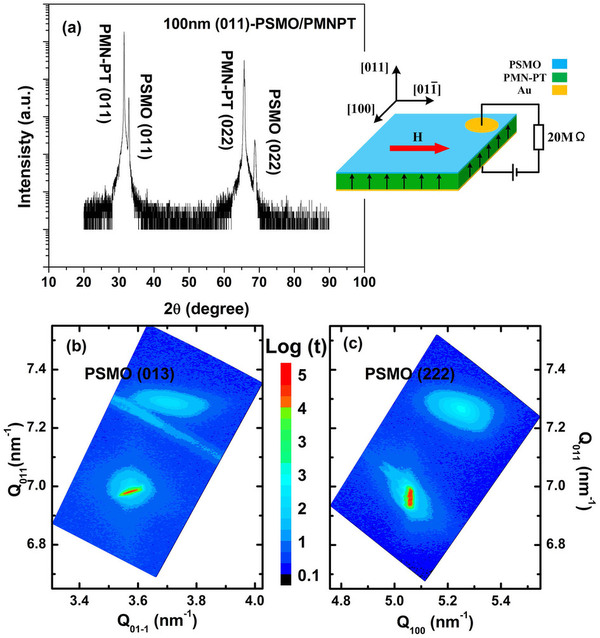Anisotropic Modulation of Magnetic Properties and Memory Effect in Wide-band (011)-Pr0.7Sr0.3MnO3/PMN-PT
By researchers in China and Saudi Arabia
By Francis Pelletier | May 5, 2015 at 2:50 pmNature, Scientific Reports has published an article written by Ying-Ying Zhao, Jing Wang, Hao Kuang, Feng-Xia Hu, Yao Liu, Rong-Rong Wu, Beijing National Laboratory for Condensed Matter Physics and the State Key Laboratory of Magnetism, Institute of Physics, Chinese Academy of Sciences, Beijing 100190, P. R. China, Xi-Xiang Zhang, Physical Science and Engineering, King Abdullah Univ Sci & Technol, Thuwal 23955-6900, Saudi Arabia, Ji-Rong Sun, and Bao-Gen Shen, Beijing National Laboratory for Condensed Matter Physics and the State Key Laboratory of Magnetism, Institute of Physics, Chinese Academy of Sciences, Beijing 100190, P. R. China.
X-ray diffraction patterns of the PSMO/PMN-PT
heterostructure. X-ray reciprocal space maps around (b) (222)
and (c) (013) reflections for the heterostructure.
The inset in (a) shows the schematic circuit diagram
for magnetic measurements under electric bias.
Abstract: “Memory effect of electric-field control on magnetic behavior in magnetoelectric composite heterostructures has been a topic of interest for a long time. Although the piezostrain and its transfer across the interface of ferroelectric/ferromagnetic films are known to be important in realizing magnetoelectric coupling, the underlying mechanism for nonvolatile modulation of magnetic behaviors remains a challenge. Here, we report on the electric-field control of magnetic properties in wide-band (011)-Pr0.7Sr0.3MnO3/0.7Pb(Mg1/3Nb2/3)O3-0.3PbTiO3 heterostructures. By introducing an electric-field-induced in-plane anisotropic strain field during the cooling process from room temperature, we observe an in-plane anisotropic, nonvolatile modulation of magnetic properties in a wide-band Pr0.7Sr0.3MnO3 film at low temperatures. We attribute this anisotropic memory effect to the preferential seeding and growth of ferromagnetic (FM) domains under the anisotropic strain field. In addition, we find that the anisotropic, nonvolatile modulation of magnetic properties gradually diminishes as the temperature approaches FM transition, indicating that the nonvolatile memory effect is temperature dependent. By taking into account the competition between thermal energy and the potential barrier of the metastable magnetic state induced by the anisotropic strain field, this distinct memory effect is well explained, which provides a promising approach for designing novel electric-writing magnetic memories.“













 Subscribe to our free daily newsletter
Subscribe to our free daily newsletter
